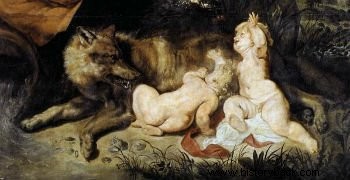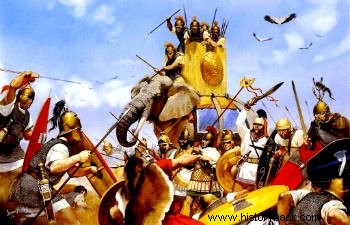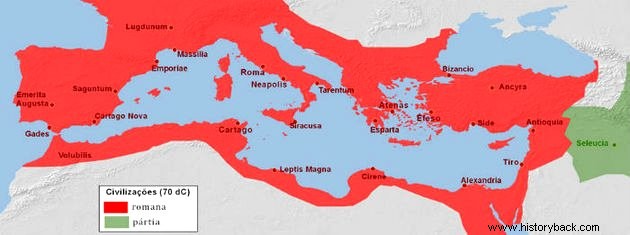The city of Rome was born as a small village and became one of the greatest empires of antiquity.
Located on the Italian Peninsula, the center of the European Mediterranean, Rome was the center of political and economic life in the region.
Rome Foundation
The foundation of Rome is shrouded in legend. According to the narrative of the poet Virgil, in his work Aeneid, the Romans descend from Aeneas, a Trojan hero, who fled to Italy after the destruction of Troy by the Greeks, around 1400 BC.
Legend has it that the twins Romulus and Remus, descendants of Aeneas, were thrown into the river Tiber, by order of Amulius, usurper of the throne.

Detail of a painting by Rubens depicting Romulus and Remus suckled by a wolf
Breastfed by a she-wolf and later raised by a peasant, the brothers return to dethrone Amulius.
The brothers were given the mission to found Rome in 753 BC. Romulus, after disagreements, murdered Remus and became the first king of Rome.
In fact, Rome was formed from the merger of seven small villages of Latin and Sabine shepherds situated on the banks of the River Tiber. After being conquered by the Etruscans, it became a true city-state.
Learn more about the legend of Romulus and Remus.
Roman Monarchy (753 BC to 509 BC)
In monarchical Rome, society was basically formed by three social classes:
- the patricians, the ruling class, formed by nobles and landowners;
- the commoners, who were made up of merchants, artisans, peasants and small landowners;
- customers, who lived on the dependence of patricians and plebeians, and were service providers.
In the Roman monarchy, the king exercised executive, judicial and religious functions.
He was assisted by the Curiata Assembly, which was made up of thirty heads of families of the people. Their function changed over the centuries, but they were responsible for drafting laws, legal remedies and ratifying the king's election. In certain periods the Curiata Assembly held more power than the Senate.
The Senate, composed of patricians, advised the king and had the power to veto the laws presented by the monarch.
The legends narrate the events of the seven reigns of the time. During the rule of the last three, who were Etruscans, the political power of the patricians declined.
The approach of the kings with the plebs displeased the patricians. In 509 BC, the last Etruscan king was deposed and a political coup marked the end of the monarchy.
Roman Republic (509 BC to 27 BC)
The establishment of the republic meant the affirmation of the Senate, the body of greatest political power among the Romans. The executive power was in charge of the magistracies, occupied by the patricians.
The Roman Republic was marked by the class struggle between patricians and plebeians. The patricians fought to preserve privileges and defend their political and economic interests, keeping the plebeians under their domination.
Between 449 and 287 BC the plebeians organized five revolts that resulted in several conquests:Tribunes of the Plebs, Laws of the XII Tables, Laws Licinia and Law Canuleia. With these measurements, the two classes were practically equal.
Learn more about the Roman Republic.
The Roman Expansion

During the Punic War elephants were used as combat animals
The first stage of the Roman conquests was marked by the domination of the entire Iberian Peninsula from the 4th century BC.
The second stage was the beginning of the Wars of Rome against Carthage, called the Punic Wars (264 to 146 BC). In 146 BC Carthage was completely destroyed. In just over a hundred years, the entire Mediterranean basin was already Rome's.
Crisis of the Republic
In the Roman Republic, slavery was the basis of all production and the number of slaves exceeded those of free men. Violence against slaves caused dozens of revolts.
One of the major slave revolts was led by Spartacus from 73 to 71 BC. At the head of the rebel forces, Spartacus threatened the power of Rome.
To balance the political forces, in 60 BC, the Senate appointed three political leaders to the consulship, Pompey, Crassus and Julius Caesar, who formed the first Triumvirate .
After the death of Julius Caesar, the second Triumvirate was instituted made up of Mark Antony, Octavio Augustus and Lepidus.
Power struggles were frequent. Octavius received the title of Prince (first citizen) from the Senate and was the first phase of the empire disguised as a Republic.
Roman Empire (27 BC to 476)

Map of territories dominated by the Roman Empire around 70 AD
Emperor Octavius Augustus (27 BC to 14 BC) reorganized Roman society. He widened the distribution of bread and wheat and of public amusements-the policy of bread and circuses .
After Augustus, several dynasties followed. Among the main emperors are:
- Tiberius (14 to 37);
- Caligula (37 to 41);
- Nero (54 to 68);
- Titus (79 to 81);
- Trajan (98 to 117);
- Hadrian (117-138);
- Marcus Aurelius (161 to 180).
Also read:Roman Empire and Roman Emperors.
Decline of the Roman Empire
From 235, the Empire began to be ruled by soldier-emperors, whose main objective was to fight the invasions.
From a political point of view, the third century was characterized by the return of military anarchy. In a span of just half a century (235 to 284) Rome had 26 emperors, of whom 24 were murdered.
With the death of Emperor Theodosius in 395, the Roman Empire was divided between his sons Honorius and Arcadius.
Honorius took the Western Roman Empire , capital Rome, and Arcadius took the Roman Empire of East , capital Constantinople.
In 476, the Western Roman Empire disintegrated and Emperor Romulus Augustus was deposed. The year 476 is considered by historians as the turning point from Antiquity to the Middle Ages.
Of the mighty Rome, only the Eastern Roman Empire remained, which would remain until 1453.
Curiosities
- Due to territorial expansion, during the empire, the Romans came to represent 25% of the world's population.
- Lefties were seen as unlucky and unreliable. This belief remained until recently, when children were forced to write with their right hands.
- The Romans were very hygienic. The wealthy classes had running water at home and the poor had springs close to their homes. They also regularly went to the public baths.
- Urine was used for various purposes because of the acid and other components:used to whiten teeth, wash clothes and make coins.
Vestibular Questions
1. (Mackenzie) The Punic Wars, conflicts between Rome and Carthage, in the 2nd century BC, were motivated:
a) the dispute over control of the Black Sea trade and possession of Greek colonies.
b) for the control of the regions of Thrace and Macedonia and the monopoly of trade in the Mediterranean.
c) for the domain of Sicily and dispute for the control of the commerce in the Mediterranean Sea.
d) for the division of the Roman Empire between the Roman generals and the submission of Syracuse to Carthage.
e) by the conflict between the expanding Roman world and the Persian barbarian world.
c) for the domain of Sicily and dispute for the control of the commerce in the Mediterranean Sea.
2. (Mackenzie) During the Roman Republic, the achievement of civil and political equality, the plebeian tribunes and the law of the Twelve Tables were ensued:
a) the political marginalization, social discrimination and economic inequality that affected the Roman plebs.
b) the crisis of the slave production system, transforming slaves into colonists and the consequent decline of agriculture.
c) the high power of the army, which, in order to contain the pressure of the barbarian invasions, carried out political and administrative reforms.
d) the influx of wealth to Rome due to the conquests and weakening of the equestrian class.
e) the rise of Christianity that preached the equality of all men.
a) the political marginalization, social discrimination and economic inequality that affected the Roman plebs.
